10.DRF-认证
Django rest framework源码分析(1)----认证
一、基础
1.1.安装
两种方式:
- github
- pip直接安装
pip install djangorestframework
1.2.需要先了解的一些知识
理解下面两个知识点非常重要,django-rest-framework源码中到处都是基于CBV和面向对象的封装
(1)面向对象封装的两大特性
把同一类方法封装到类中将数据封装到对象中
(2)CBV
基于反射实现根据请求方式不同,执行不同的方法
原理:url-->view方法-->dispatch方法(反射执行其它方法:GET/POST/PUT/DELETE等等)
二、简单实例
2.1.settings
先创建一个project和一个app(我这里命名为API)
首先要在settings的app中添加
INSTALLED_APPS = ['rest_framework',]
2.2.url
from django.contrib import adminfrom django.urls import pathfrom API.views import AuthViewurlpatterns = [path('admin/', admin.site.urls),path('api/v1/auth/',AuthView.as_view()),]
2.3.models
一个保存用户的信息
一个保存用户登录成功后的token
from django.db import modelsclass UserInfo(models.Model):USER_TYPE = ((1,'普通用户'),(2,'VIP'),(3,'SVIP'))user_type = models.IntegerField(choices=USER_TYPE)username = models.CharField(max_length=32)password = models.CharField(max_length=64)class UserToken(models.Model):user = models.OneToOneField(UserInfo,on_delete=models.CASCADE)token = models.CharField(max_length=64)
2.4.views
用户登录(返回token并保存到数据库)
from django.shortcuts import renderfrom django.http import JsonResponsefrom rest_framework.views import APIViewfrom API import modelsdef md5(user):import hashlibimport time#当前时间,相当于生成一个随机的字符串ctime = str(time.time())m = hashlib.md5(bytes(user,encoding='utf-8'))m.update(bytes(ctime,encoding='utf-8'))return m.hexdigest()class AuthView(object):def post(self,request,*args,**kwargs):ret = {'code':1000,'msg':None}try:user = request._request.POST.get('username')pwd = request._request.POST.get('password')obj = models.UserInfo.objects.filter(username=user,password=pwd).first()if not obj:ret['code'] = 1001ret['msg'] = '用户名或密码错误'#为用户创建tokentoken = md5(user)#存在就更新,不存在就创建models.UserToken.objects.update_or_create(user=obj,defaults={'token':token})ret['token'] = tokenexcept Exception as e:ret['code'] = 1002ret['msg'] = '请求异常'return JsonResponse(ret)
2.5.利用postman发请求

如果用户名和密码正确的话 会生成token值,下次该用户再登录时,token的值就会更新
数据库中可以看到token的值

当用户名或密码错误时,抛出异常
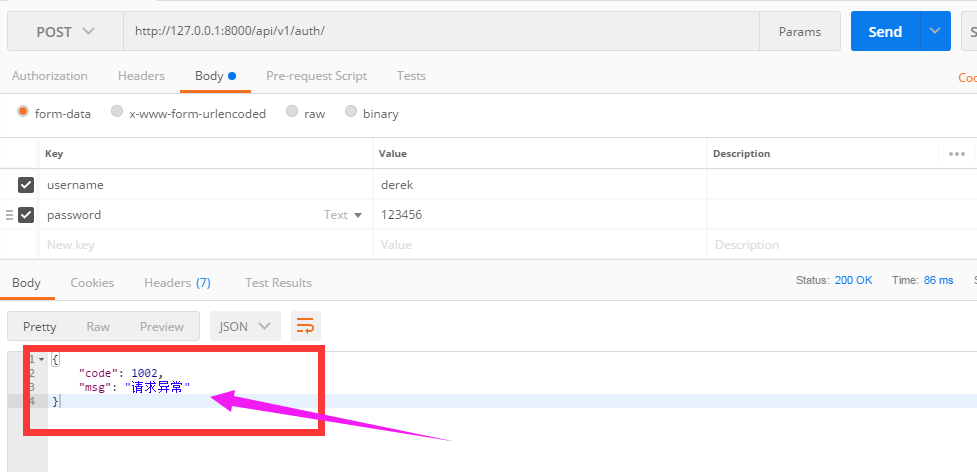
三、添加认证
基于上面的例子,添加一个认证的类
3.1.url
path('api/v1/order/',OrderView.as_view()),
3.2.views
from django.shortcuts import render,HttpResponsefrom django.http import JsonResponsefrom rest_framework.views import APIViewfrom API import modelsfrom rest_framework.request import Requestfrom rest_framework import exceptionsfrom rest_framework.authentication import BasicAuthenticationORDER_DICT = {1:{'name':'apple','price':15},2:{'name':'dog','price':100}}def md5(user):import hashlibimport time#当前时间,相当于生成一个随机的字符串ctime = str(time.time())m = hashlib.md5(bytes(user,encoding='utf-8'))m.update(bytes(ctime,encoding='utf-8'))return m.hexdigest()class AuthView(object):'''用于用户登录验证'''def post(self,request,*args,**kwargs):ret = {'code':1000,'msg':None}try:user = request._request.POST.get('username')pwd = request._request.POST.get('password')obj = models.UserInfo.objects.filter(username=user,password=pwd).first()if not obj:ret['code'] = 1001ret['msg'] = '用户名或密码错误'#为用户创建tokentoken = md5(user)#存在就更新,不存在就创建models.UserToken.objects.update_or_create(user=obj,defaults={'token':token})ret['token'] = tokenexcept Exception as e:ret['code'] = 1002ret['msg'] = '请求异常'return JsonResponse(ret)class Authentication(APIView):'''认证'''def authenticate(self,request):token = request._request.GET.get('token')token_obj = models.UserToken.objects.filter(token=token).first()if not token_obj:raise exceptions.AuthenticationFailed('用户认证失败')#在rest framework内部会将这两个字段赋值给request,以供后续操作使用return (token_obj.user,token_obj)def authenticate_header(self, request):passclass OrderView(APIView):'''订单相关业务'''authentication_classes = [Authentication,] #添加认证def get(self,request,*args,**kwargs):#request.user#request.authret = {'code':1000,'msg':None,'data':None}try:ret['data'] = ORDER_DICTexcept Exception as e:passreturn JsonResponse(ret)
3.3用postman发get请求
请求的时候没有带token,可以看到会显示“用户认证失败”

这样就达到了认证的效果,django-rest-framework的认证是怎么实现的呢,下面基于这个例子来剖析drf的源码。
四、drf的认证源码分析
源码流程图
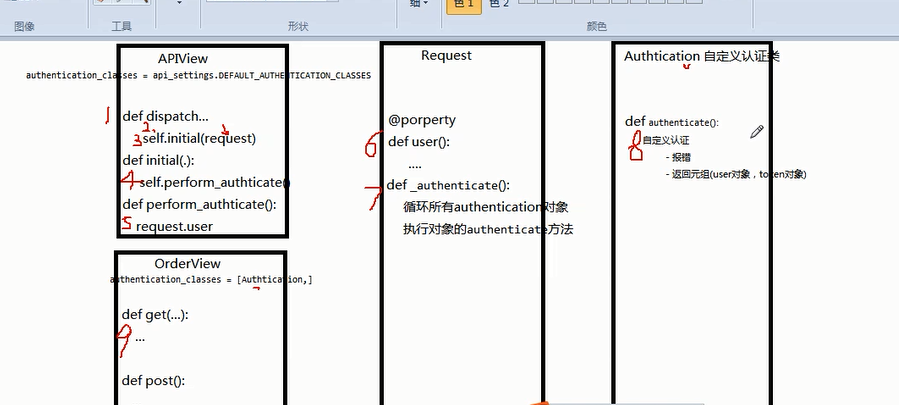
请求先到dispatch
dispatch()主要做了两件事
- 封装request
- 认证
具体看我写的代码里面的注释
def dispatch(self, request, *args, **kwargs):"""`.dispatch()` is pretty much the same as Django's regular dispatch,but with extra hooks for startup, finalize, and exception handling."""self.args = argsself.kwargs = kwargs#对原始request进行加工,丰富了一些功能#Request(# request,# parsers=self.get_parsers(),# authenticators=self.get_authenticators(),# negotiator=self.get_content_negotiator(),# parser_context=parser_context# )#request(原始request,[BasicAuthentications对象,])#获取原生request,request._request#获取认证类的对象,request.authticators#1.封装requestrequest = self.initialize_request(request, *args, **kwargs)self.request = requestself.headers = self.default_response_headers # deprecate?try:#2.认证self.initial(request, *args, **kwargs)# Get the appropriate handler methodif request.method.lower() in self.http_method_names:handler = getattr(self, request.method.lower(),self.http_method_not_allowed)else:handler = self.http_method_not_allowedresponse = handler(request, *args, **kwargs)except Exception as exc:response = self.handle_exception(exc)self.response = self.finalize_response(request, response, *args, **kwargs)return self.response
4.1.reuqest
(1)initialize_request()
可以看到initialize()就是封装原始request
def initialize_request(self, request, *args, **kwargs):"""Returns the initial request object."""parser_context = self.get_parser_context(request)return Request(request,parsers=self.get_parsers(),#[BasicAuthentication(),],把对象封装到request里面了authenticators=self.get_authenticators(),negotiator=self.get_content_negotiator(), parser_context=parser_context )
(2)get_authenticators()
通过列表生成式,返回对象的列表
def get_authenticators(self):"""Instantiates and returns the list of authenticators that this view can use."""return [auth() for auth in self.authentication_classes]
(3)authentication_classes
APIView里面有个 authentication_classes 字段
可以看到默认是去全局的配置文件找(api_settings)
class APIView(View):# The following policies may be set at either globally, or per-view.renderer_classes = api_settings.DEFAULT_RENDERER_CLASSESparser_classes = api_settings.DEFAULT_PARSER_CLASSESauthentication_classes = api_settings.DEFAULT_AUTHENTICATION_CLASSESthrottle_classes = api_settings.DEFAULT_THROTTLE_CLASSESpermission_classes = api_settings.DEFAULT_PERMISSION_CLASSEScontent_negotiation_class = api_settings.DEFAULT_CONTENT_NEGOTIATION_CLASSmetadata_class = api_settings.DEFAULT_METADATA_CLASSversioning_class = api_settings.DEFAULT_VERSIONING_CLASS
4.2.认证
self.initial(request, *args, **kwargs)
def dispatch(self, request, *args, **kwargs):"""`.dispatch()` is pretty much the same as Django's regular dispatch,but with extra hooks for startup, finalize, and exception handling."""self.args = argsself.kwargs = kwargs#对原始request进行加工,丰富了一些功能#Request(# request,# parsers=self.get_parsers(),# authenticators=self.get_authenticators(),# negotiator=self.get_content_negotiator(),# parser_context=parser_context# )#request(原始request,[BasicAuthentications对象,])#获取原生request,request._request#获取认证类的对象,request.authticators#1.封装requestrequest = self.initialize_request(request, *args, **kwargs)self.request = requestself.headers = self.default_response_headers # deprecate?try:#2.认证self.initial(request, *args, **kwargs)# Get the appropriate handler methodif request.method.lower() in self.http_method_names:handler = getattr(self, request.method.lower(),self.http_method_not_allowed)else:handler = self.http_method_not_allowedresponse = handler(request, *args, **kwargs)except Exception as exc:response = self.handle_exception(exc)self.response = self.finalize_response(request, response, *args, **kwargs)return self.response
(1)initial()
主要看 self.perform_authentication(request),实现认证
def initial(self, request, *args, **kwargs):"""Runs anything that needs to occur prior to calling the method handler."""self.format_kwarg = self.get_format_suffix(**kwargs)# Perform content negotiation and store the accepted info on the requestneg = self.perform_content_negotiation(request)request.accepted_renderer, request.accepted_media_type = neg# Determine the API version, if versioning is in use.version, scheme = self.determine_version(request, *args, **kwargs)request.version, request.versioning_scheme = version, scheme# Ensure that the incoming request is permitted#3.实现认证self.perform_authentication(request)self.check_permissions(request)self.check_throttles(request)
(2)perform_authentication()
调用了request.user
def perform_authentication(self, request):"""Perform authentication on the incoming request.Note that if you override this and simply 'pass', then authenticationwill instead be performed lazily, the first time either`request.user` or `request.auth` is accessed."""request.user
(3)user
request.user的request的位置

点进去可以看到Request有个user方法,加 @property 表示调用user方法的时候不需要加括号“user()”,可以直接调用:request.user
@propertydef user(self):"""Returns the user associated with the current request, as authenticatedby the authentication classes provided to the request."""if not hasattr(self, '_user'):with wrap_attributeerrors():#获取认证对象,进行一步步的认证self._authenticate()return self._user
(4)_authenticate()
循环所有authenticator对象
def _authenticate(self):"""Attempt to authenticate the request using each authentication instancein turn."""#循环认证类的所有对象#执行对象的authenticate方法for authenticator in self.authenticators:try:#执行认证类的authenticate方法#这里分三种情况#1.如果authenticate方法抛出异常,self._not_authenticated()执行#2.有返回值,必须是元组:(request.user,request.auth)#3.返回None,表示当前认证不处理,等下一个认证来处理user_auth_tuple = authenticator.authenticate(self)except exceptions.APIException:self._not_authenticated()raiseif user_auth_tuple is not None:self._authenticator = authenticatorself.user, self.auth = user_auth_tuplereturnself._not_authenticated()
返回值就是例子中的:
token_obj.user-->>request.usertoken_obj-->>request.auth#在rest framework内部会将这两个字段赋值给request,以供后续操作使用return (token_obj.user,token_obj) #例子中的return
当都没有返回值,就执行self._not_authenticated(),相当于匿名用户,没有通过认证
def _not_authenticated(self):"""Set authenticator, user & authtoken representing an unauthenticated request.Defaults are None, AnonymousUser & None."""self._authenticator = Noneif api_settings.UNAUTHENTICATED_USER:self.user = api_settings.UNAUTHENTICATED_USER() #AnonymousUser匿名用户else:self.user = Noneif api_settings.UNAUTHENTICATED_TOKEN:self.auth = api_settings.UNAUTHENTICATED_TOKEN() #Noneelse:self.auth = None
面向对象知识:
子类继承 父类,调用方法的时候:
- 优先去自己里面找有没有这个方法,有就执行自己的
- 只有当自己里面没有这个方法的时候才会去父类找
因为authenticate方法我们自己写,所以当执行authenticate()的时候就是执行我们自己写的认证
父类中的authenticate方法
def authenticate(self, request):return (self.force_user, self.force_token)
我们自己写的
class Authentication(APIView):'''用于用户登录验证'''def authenticate(self,request):token = request._request.GET.get('token')token_obj = models.UserToken.objects.filter(token=token).first()if not token_obj:raise exceptions.AuthenticationFailed('用户认证失败')#在rest framework内部会将这两个字段赋值给request,以供后续操作使用return (token_obj.user,token_obj)
认证的流程就是上面写的,弄懂了原理,再写代码就更容易理解为什么了。
4.3.配置文件
继续解读源码

默认是去全局配置文件中找,所以我们应该在settings.py中配置好路径
api_settings源码
api_settings = APISettings(None, DEFAULTS, IMPORT_STRINGS)def reload_api_settings(*args, **kwargs):setting = kwargs['setting']if setting == 'REST_FRAMEWORK':api_settings.reload()
setting中‘REST_FRAMEWORK’中找
全局配置方法:
API文件夹下面新建文件夹utils,再新建auth.py文件,里面写上认证的类
settings.py
#设置全局认证REST_FRAMEWORK = {"DEFAULT_AUTHENTICATION_CLASSES":['API.utils.auth.Authentication',] #里面写你的认证的类的路径}
auth.py
# API/utils/auth.pyfrom rest_framework import exceptionsfrom API import modelsclass Authentication(object):'''用于用户登录验证'''def authenticate(self,request):token = request._request.GET.get('token')token_obj = models.UserToken.objects.filter(token=token).first()if not token_obj:raise exceptions.AuthenticationFailed('用户认证失败')#在rest framework内部会将这两个字段赋值给request,以供后续操作使用return (token_obj.user,token_obj)def authenticate_header(self, request):pass
在settings里面设置的全局认证,所有业务都需要经过认证,如果想让某个不需要认证,只需要在其中添加下面的代码:
authentication_classes = [] #里面为空,代表不需要认证
from django.shortcuts import render,HttpResponsefrom django.http import JsonResponsefrom rest_framework.views import APIViewfrom API import modelsfrom rest_framework.request import Requestfrom rest_framework import exceptionsfrom rest_framework.authentication import BasicAuthenticationORDER_DICT = {1:{'name':'apple','price':15},2:{'name':'dog','price':100}}def md5(user):import hashlibimport time#当前时间,相当于生成一个随机的字符串ctime = str(time.time())m = hashlib.md5(bytes(user,encoding='utf-8'))m.update(bytes(ctime,encoding='utf-8'))return m.hexdigest()class AuthView(APIView):'''用于用户登录验证'''authentication_classes = [] #里面为空,代表不需要认证def post(self,request,*args,**kwargs):ret = {'code':1000,'msg':None}try:user = request._request.POST.get('username')pwd = request._request.POST.get('password')obj = models.UserInfo.objects.filter(username=user,password=pwd).first()if not obj:ret['code'] = 1001ret['msg'] = '用户名或密码错误'#为用户创建tokentoken = md5(user)#存在就更新,不存在就创建models.UserToken.objects.update_or_create(user=obj,defaults={'token':token})ret['token'] = tokenexcept Exception as e:ret['code'] = 1002ret['msg'] = '请求异常'return JsonResponse(ret)class OrderView(APIView):'''订单相关业务'''def get(self,request,*args,**kwargs):# self.dispatch#request.user#request.authret = {'code':1000,'msg':None,'data':None}try:ret['data'] = ORDER_DICTexcept Exception as e:passreturn JsonResponse(ret)API/view.py代码
再测试一下我们的代码
不带token发请求
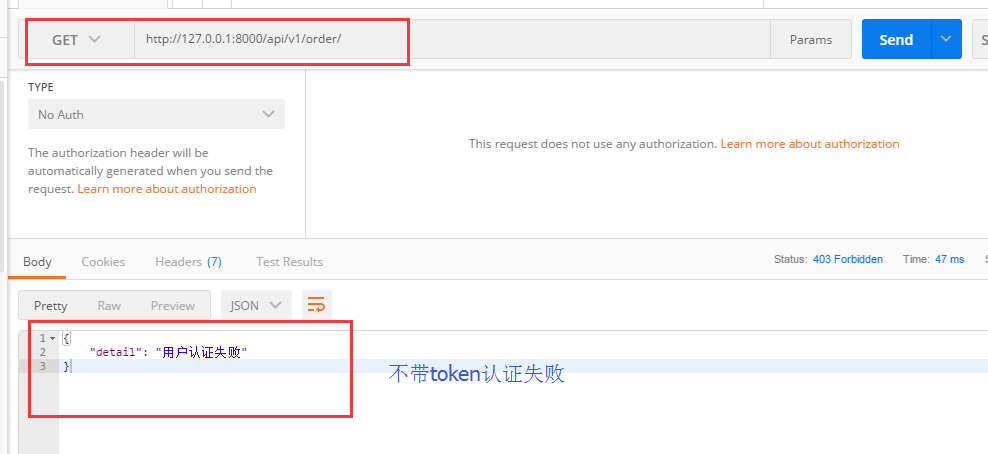
带token发请求
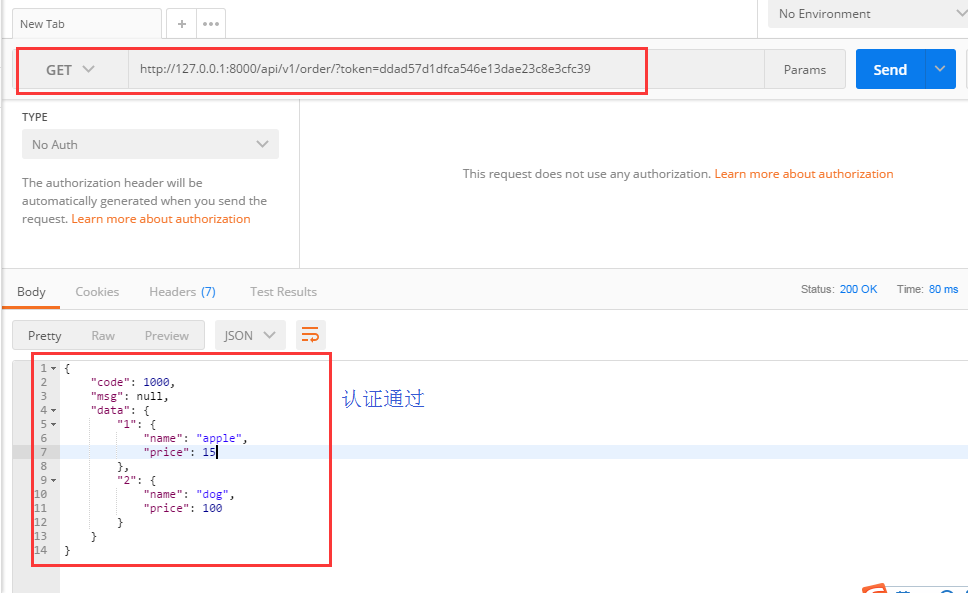
五、drf的内置认证
rest_framework里面内置了一些认证,我们自己写的认证类都要继承内置认证类 "BaseAuthentication"
4.1.BaseAuthentication源码:
class BaseAuthentication(object):"""All authentication classes should extend BaseAuthentication."""def authenticate(self, request):"""Authenticate the request and return a two-tuple of (user, token)."""#内置的认证类,authenticate方法,如果不自己写,默认则抛出异常raise NotImplementedError(".authenticate() must be overridden.")def authenticate_header(self, request):"""Return a string to be used as the value of the `WWW-Authenticate`header in a `401 Unauthenticated` response, or `None` if theauthentication scheme should return `403 Permission Denied` responses."""#authenticate_header方法,作用是当认证失败的时候,返回的响应头pass
4.2.修改自己写的认证类
自己写的Authentication必须继承内置认证类BaseAuthentication
# API/utils/auth/pyfrom rest_framework import exceptionsfrom API import modelsfrom rest_framework.authentication import BaseAuthenticationclass Authentication(BaseAuthentication):'''用于用户登录验证'''def authenticate(self,request):token = request._request.GET.get('token')token_obj = models.UserToken.objects.filter(token=token).first()if not token_obj:raise exceptions.AuthenticationFailed('用户认证失败')#在rest framework内部会将这两个字段赋值给request,以供后续操作使用return (token_obj.user,token_obj)def authenticate_header(self, request):pass
4.3.其它内置认证类
rest_framework里面还内置了其它认证类,我们主要用到的就是BaseAuthentication,剩下的很少用到
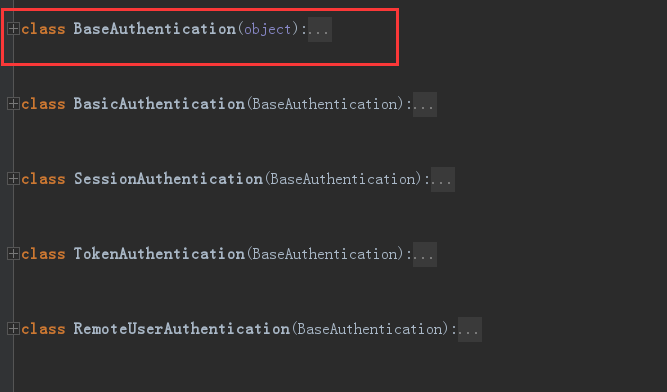
六、总结
自己写认证类方法梳理
(1)创建认证类
- 继承BaseAuthentication --->>1.重写authenticate方法;2.authenticate_header方法直接写pass就可以(这个方法必须写)
(2)authenticate()返回值(三种)
- None ----->>>当前认证不管,等下一个认证来执行
- raise exceptions.AuthenticationFailed('用户认证失败') # from rest_framework import exceptions
- 有返回值元祖形式:(元素1,元素2) #元素1复制给request.user; 元素2复制给request.auth
(3)局部使用
- authentication_classes = [BaseAuthentication,]
(4)全局使用
#设置全局认证REST_FRAMEWORK = {"DEFAULT_AUTHENTICATION_CLASSES":['API.utils.auth.Authentication',]}
源码流程
--->>dispatch
--封装request
---获取定义的认证类(全局/局部),通过列表生成式创建对象
---initial
----peform_authentication
-----request.user (每部循环创建的对象)
10.DRF-认证的更多相关文章
- DRF 认证、权限、限制
DRF 认证.权限.限制 认证: 定义一个用户表和一个保存用户的Token表 # ======================day96======================= class ...
- python 全栈开发,Day97(Token 认证的来龙去脉,DRF认证,DRF权限,DRF节流)
昨日内容回顾 1. 五个葫芦娃和三行代码 APIView(views.View) 1. 封装了Django的request - request.query_params --> 取URL中的参数 ...
- (四) DRF认证, 权限, 节流
一.Token 认证的来龙去脉 摘要 Token 是在服务端产生的.如果前端使用用户名/密码向服务端请求认证,服务端认证成功,那么在服务端会返回 Token 给前端.前端可以在每次请求的时候带上 To ...
- drf认证组件、权限组件、jwt认证、签发、jwt框架使用
目录 一.注册接口 urls.py views.py serializers.py 二.登录接口 三.用户中心接口(权限校验) urls.py views.py serializers.py 四.图书 ...
- DRF认证组件
1.DRF认证组件之视图注册用法(自定义简单使用) settings.py配置 INSTALLED_APPS = [ 'django.contrib.admin', 'django.contrib.a ...
- drf 认证功能
drf(django rest-framework)认证组件 复习 HyperlinkedIdentityField ```python 功能:快速生成连接 1. publish = seriali ...
- 【DRF认证】
目录 认证组件的详细用法 本文详细讲述了DRF认证组件的原理以及用法. @ * 源码剖析** 上一篇博客讲解DRF版本的时候我们都知道了,在dispatch方法里执行了initial方法来初始化我们的 ...
- 三 drf 认证,权限,限流,过滤,排序,分页,异常处理,接口文档,集xadmin的使用
因为接下来的功能中需要使用到登陆功能,所以我们使用django内置admin站点并创建一个管理员. python manage.py createsuperuser 创建管理员以后,访问admin站点 ...
- drf 认证、权限、限流、过滤、排序、分页器
认证Authentication 准备工作:(需要结合权限用) 1. 需要使用到登陆功能,所以我们使用django内置admin站点并创建一个管理员. python manage.py creates ...
- Django -- DRF 认证流程
Django Restful Framework (DRF)中类的调用与自定义-- 以 autentication 认证为例 DRF 的 request 对 django 的 request 进行了更 ...
随机推荐
- 永久关闭windows更新步骤
在搜索“web和windows”框中输入“服务” 在搜索结果中点击第一个,那个图标像齿轮的那个!如下图. 在打开的“服务”窗口中,我们找到windows update 找到”windows upd ...
- ## 0521Day04内部类
[重点] Math公式 静态导入 正则表达式 内部类 访问修饰符 [Math] Math包的相关方法: round:四舍五入:-10.9==>-11/-11.2==>-11 floor:向 ...
- JavaScript变量语法扩展
1.更新变量 一个变量被重新赋值后,它原有的值会被覆盖,变量值将会以最后一次赋值为准. 2.同时声明多个变量 var age = 18 , address ='火影村' , gz = 2000 ; ...
- [ES6系列-07]Generator Function: 生成器函数
[原创]码路工人 Coder-Power 大家好,这里是码路工人有力量,我是码路工人,你们是力量. github-pages 博客园cnblogs Generator function 生成器函数是E ...
- 解决google play上架App设置隐私政策声明问题
在我们的app上架到google play后,为了赚点小钱,就集成google ads,然而这会引发一个新的问题,那就是设置隐私政策声明的问题,通常我们会收到一封来自google play的邮件,提示 ...
- Rocket - debug - TLDebugModuleInnerAsync
https://mp.weixin.qq.com/s/Xf4VFTHIDFh1NHmfwlTX3w 简单介绍TLDebugModuleInnerAsync的实现. 1. dmInner dmInner ...
- GTA5侠盗猎车5中文版破解版绿色版汉化版迅雷下载地址种子实测可用
GTA5(侠盗猎车5)中文版下载地址(实测可用) 迅雷下载地址:https://www.90pan.com/b1548988 一定要关闭安全软件并且加入白名单 实测通过,关闭杀毒软件可以完美运行,最好 ...
- Java实现 LeetCode 647 回文子串(暴力)
647. 回文子串 给定一个字符串,你的任务是计算这个字符串中有多少个回文子串. 具有不同开始位置或结束位置的子串,即使是由相同的字符组成,也会被计为是不同的子串. 示例 1: 输入: "a ...
- Java实现蓝桥杯模拟正整数序列的数量
问题描述 小明想知道,满足以下条件的正整数序列的数量: 1. 第一项为 n: 2. 第二项不超过 n: 3. 从第三项开始,每一项小于前两项的差的绝对值. 请计算,对于给定的 n,有多少种满足条件的序 ...
- Java实现 LeetCode 274 H指数
274. H指数 给定一位研究者论文被引用次数的数组(被引用次数是非负整数).编写一个方法,计算出研究者的 h 指数. h 指数的定义: "h 代表"高引用次数"(hig ...
